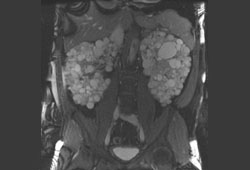Resumo
Definição
História e exame físico
Principais fatores diagnósticos
- história familiar de DRP autossômica dominante (DRPAD) ou doença renal em estágio terminal
- história familiar de evento cerebrovascular.
- cistos renais
- hipertensão
- dor abdominal/nos flancos
- hematúria
- massa abdominal/renal palpável
- cefaleias
- disúria, dor suprapúbica, febre
Outros fatores diagnósticos
- sopro cardíaco
- hérnia abdominal
- hepatomegalia
- dor torácica
Fatores de risco
- história familiar de DRP autossômica dominante (DRPAD)
- história familiar de evento cerebrovascular.
Investigações diagnósticas
Primeiras investigações a serem solicitadas
- ultrassonografia renal
- tomografia computadorizada (TC) de abdome/pelve
- RNM de abdome/pelve
- urinálise/cultura de urina e coloração de Gram
- eletrólitos séricos, ureia e creatinina
- perfil lipídico em jejum
- eletrocardiograma (ECG)
- TC cranioencefálica
Investigações a serem consideradas
- teste genético
- ecocardiograma
- urina de 24 horas
- TC de dupla energia do abdome/pelve
- punção lombar e análise do líquido cefalorraquidiano
- proteína C-reativa
- tomografia por emissão de pósitrons (PET)
Algoritmo de tratamento
doença policística autossômica dominante confirmada
doença renal em estágio terminal
Colaboradores
Autores
Marie C. Hogan, MD, PhD
Consultant
Division of Nephrology
Professor of Medicine
College of Medicine
Mayo Clinic
Rochester
MN
Declarações
MCH receives research funding from Novartis, and was an investigator participating in tolvaptan clinical trials. MCH is also an author of several references cited in this topic.
Maria Irazabel Mira, MD, PhD
Associate Professor of Medicine, Associate Consultant
Division of Nephrology and Hypertension
Department of Internal Medicine
Mayo Clinic
Rochester
MN
Declarações
MIM is an author of several references cited in this topic.
Agradecimentos
Dr Marie C Hogan and Dr Maria Irazabal Mira would like to gratefully acknowledge Dr Vicente Torres, a previous contributor to this topic.
Disclosures: VT is an author of several references cited in this topic.
Revisores
Richard Sandford, PhD, FRCP
Wellcome Trust Senior Fellow in Clinical Research
University Reader in Real Genetics
Honorary Consultant in Medical Genetics
Cambridge
UK
Declarações
RS declares that he has no competing interests.
Arlene Chapman, MD
Professor of Medicine
Renal Division
Emory University
School of Medicine
Atlanta
GA
Declarações
Not disclosed.
Créditos aos pareceristas
Os tópicos do BMJ Best Practice são constantemente atualizados, seguindo os desenvolvimentos das evidências e das diretrizes. Os pareceristas aqui listados revisaram o conteúdo pelo menos uma vez durante a história do tópico.
Declarações
As afiliações e declarações dos pareceristas referem--se ao momento da revisão.
Referências
Principais artigos
Bergmann C, Guay-Woodford LM, Harris PC, et al. Polycystic kidney disease. Nat Rev Dis Primers. 2018 Dec 6;4(1):50.Texto completo Resumo
Cornec-Le Gall E, Alam A, Perrone RD. Autosomal dominant polycystic kidney disease. Lancet. 2019 Mar 2;393(10174):919-35. Resumo
Pei Y, Obaji J, Dupuis A, et al. Unified criteria for ultrasonographic diagnosis of ADPKD. J Am Soc Nephrol. 2009 Jan;20(1):205-12.Texto completo Resumo
Torres VE, Chapman AB, Devuyst O, et al; TEMPO 3:4 Trial Investigators. Tolvaptan in patients with autosomal dominant polycystic kidney disease. N Engl J Med. 2012 Dec 20;367(25):2407-18.Texto completo Resumo
Schrier RW, Abebe KZ, Perrone RD, et al; HALT-PKD Trial Investigators. Blood pressure in early autosomal dominant polycystic kidney disease. N Engl J Med. 2014 Dec 11;371(24):2255-66. Resumo
Torres VE, Abebe KZ, Chapman AB, et al; HALT-PKD Trial Investigators. Angiotensin blockade in late autosomal dominant polycystic kidney disease. N Engl J Med. 2014 Dec 11;371(24):2267-76. Resumo
Artigos de referência
Uma lista completa das fontes referenciadas neste tópico está disponível para os usuários com acesso total ao BMJ Best Practice.

Diagnósticos diferenciais
- Doença renal cística adquirida
- Cisto simples
- Complexo da esclerose tuberosa
Mais Diagnósticos diferenciaisDiretrizes
- Autosomal-dominant polycystic kidney disease (ADPKD): executive summary
- KHA-CARI autosomal dominant polycystic kidney disease guidelines
Mais DiretrizesFolhetos informativos para os pacientes
Nefrolitíase
Infecção renal
Mais Folhetos informativos para os pacientesCalculadoras
Taxa de filtração glomerular estimada pela equação de estudo em MDRD rastreável por IDMS
Mais CalculadorasVideos
Punção lombar diagnóstica em adultos: demonstração animada
Mais vídeosConectar-se ou assinar para acessar todo o BMJ Best Practice
O uso deste conteúdo está sujeito ao nosso aviso legal